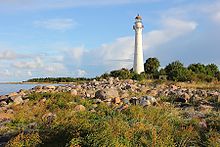

Kihnu is the largest island in the Gulf of Riga and one of the smallest municipalities in Estonia.
Villages[edit]
Understand[edit]
Kihnu is located south east from Saaremaa Island and west from the mainland.
For many years, the men of Kihnu have frequently gone to sea while the women ran the island and became the guardians of the island's cultural heritage, which includes handicrafts, dances, games and music. Unlike men, they also wear their national costumes in everyday life. So it's quite normal to see an old woman dressed in traditional clothing driving a motorbike or even a tractor.
UNESCO proclaimed Kihnu's cultural space and traditions as a Masterpiece of the Oral and Intangible Heritage of Humanity on November 7, 2003.
Climate[edit]
Because of the surrounding sea, the climate on the island is gentle and warmer than the Estonian average.
Get in[edit]
By ferry[edit]
Kihnu Island is connected by a frequent ferry service to Munalaid and Pärnu on the mainland. The ferries also carry cars. Bookings can be made via phone or internet.
See[edit]
- Kihnu Museum, ☏ +372 58188094. May-Aug daily 10-17:00, Sep Tu-Sa 10-14:00, Oct-Apr Tu-F 10-14:00. It hosts exhibits about the history of the island, the life and times of famous local captain, Kihnu Jõnn, and a collection of paintings by the renowned artist, Jaan Oad. Across the road from the museum you'll find the Kihnu Orthodox church and cemetery. €3.
- 1 Kihnu Lighthouse. 29 metres (95 ft) high and located on the southernmost headland in Kihnu.
Do[edit]
Try to visit Kihnu during traditional celebrations of popular calendar or church holidays like Christmas, Midsummer's day and St. Catherine's Day, where you can witness genuine old traditions.
It's a good location for walking, fishing and bicycling (bikes can be rented on the island).
Buy[edit]
- [dead link] Kurase kauplus, Sääre village. 10-18. Grocery store.
- Kihnu pood, Sääre village, ☏ +3725626 2181, rockcity@kihnu.ee. 09:30-18:00. Grocery store. Fresh food from Pärnu arrives on Mondays and Fridays.
- Kallase pood, Lemsi village, ☏ +372446 9908, info@kihnukallas.ee. Grocery store.
Eat[edit]
The island doesn't have an all year round open dining place. From September to May, catering is on request. There is no ATM on the island, but in most of the stores and catering establishments are able to pay by bank card.
- [dead link] Kurase kohvik, Sääre village. Open only during summer.
- [formerly dead link] Kihnu Küek, Männi Talu, Linaküla Kihnu vald. Home-restaurant; booking in advance.
Drink[edit]
- [dead link] Kurase baar, Sääre village. Open only during summer.
Sleep[edit]
- Ruudu külaliskorterid, Lemsi, ☏ +372 5144610, majutus@kihnu.ee. €20.
- Kuraga kodumajutus, Kuraga talu, Rootsi küla, ☏ +372 5291492, oie.vesik@gmail.com. +Bicycle rent. €40.
- Sadama öömaja, Rannametsa talu, Linaküla, ☏ +372 5137099, info@puhkakihnus.ee. Sauna (€20/h); Bicycle rent; Fishing trip (€85). €23.
- Ranniku majutus, ☏ +372 5071453, mare.matas@gmail.com. €20.
- Rock City, ☏ +372 56262181, rockcity@kihnu.ee. Tavern; Sauna;... €15.
- Kihnuranna puhkeküla, Sääre küla, ☏ +372 5255172, info@kihnurand.ee. Sauna; Bicycle rent; Fishing trip; €15.
- Tolli Turismitalu, Sääre küla, ☏ +372 5277380, info@kihnukallas.ee. €20.
- Kastani majutus, Kastani talu, Linaküla küla, ☏ +372 56500524, kastanimajutus@gmail.com. Sauna; Bicycle rent; Free WiFi. €18.
- Pihlaka kodumajutus, Pihlaka, Linaküla, ☏ +372 5288258, info@pihlakamajutus.ee. Sauna; Grill; Bicycle rent; Fishing trip; Car tour. €16.
- Nuki kodumajutus, Nuki talu, Sääre küla, ☏ +372 56985216, nukitalu@gmail.com. Bicycle rent. €20.
- Uibu talu kodumajutus, ☏ +372 5138557, uibutalu@gmail.com.
- Niine majutus, ☏ +372 5241754, arne.oad@gmail.com.
- Hiie kodumajutus, ☏ +372 56190370.
Go next[edit]
- Saaremaa – The largest Estonian and wild seaside character island with castles and fortresses, one perfectly preserved, a beach, a spa and famous mills. Saaremaa is even sometimes called Sparemaa. Furthermore, the island itself is surrounded by a myriad of tiny islands including Abruka with its nudist camps.
- Hiiumaa – The second largest Estonian island. Popular for its lighthouses, ancient churches, historical values and the sense of humour of its inhabitants, but scarcely populated. In winter, it can sometimes be reached by car via an ice bridge on the Baltic Sea.
- Vormsi – The fourth largest Estonian island, very close to the mainland. Vormsi is a small island covered with forests and a Swedish community. A unique blend of Soviet and Swedish history mixed with unspoilt nature.
- Pärnu – Estonia's 4th largest city and the summer capital of Estonia, popular for its balneo-therapy complexes and spa centres, surrounded by numerous beaches.
- Ruhnu – The communal territory corresponds to that of the homonymous island, formerly known as Runö.
